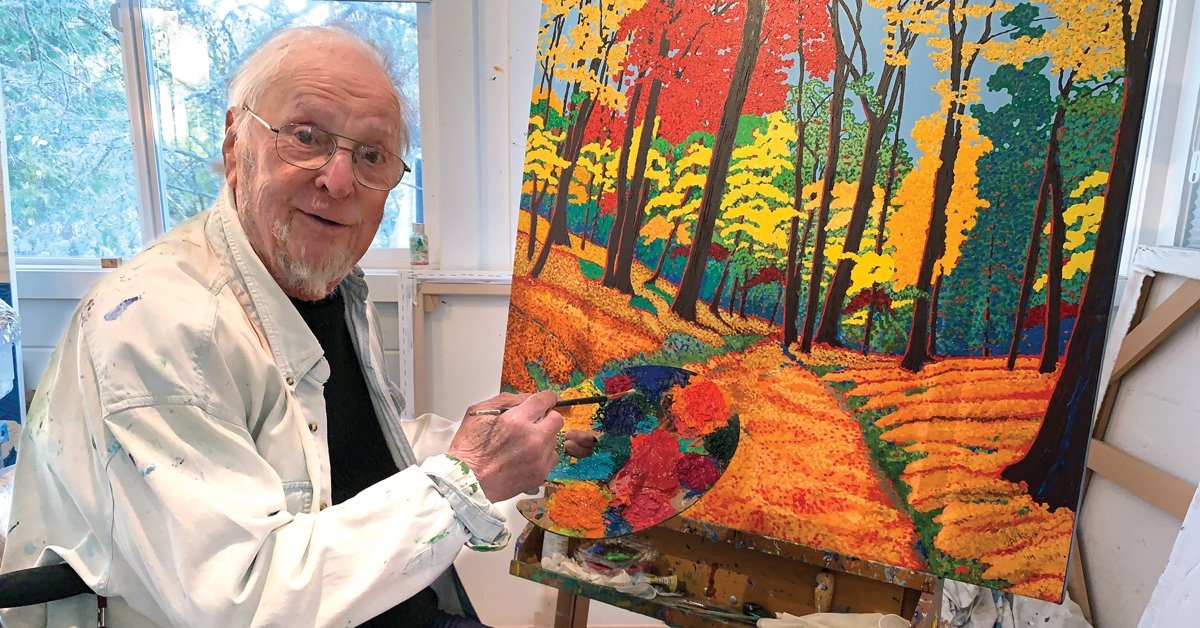Columbia College | Columbia University in the City of New York
Portraying Nature in Paint

Mark Wiley
“He put a big X on my drawing,” Stuppin recalls, laughing. “He said, ‘You’re a human being. You have a mind, a soul, a heart. Why do you want to do what an inanimate object like a camera does better?’”
The criticism might have stung, but for Stuppin, it was also freeing. “It liberated me,” he says. “I got looser. I let my emotions get involved.”
Today, Stuppin’s style as a landscape artist has evolved far from photorealistic renderings. His California and Hudson River landscapes — known for their bright, super-enriched colors — fuse a certain folk-art primitiveness with deeply personal feeling. His work is in the permanent collections of several museums, and he has had solo or group shows in galleries across the United States, including the well-known ACA Galleries in New York City and the Berggruen Gallery in San Francisco. Now in his ninth decade, Stuppin shows no signs of stopping.
Before he became a full-time artist, Stuppin, a Yonkers native, served in the Marine Corps. While awaiting orders for his peacetime deployment to Japan, he spent a month in San Francisco and fell in love with the city. When he left the military in 1958, he made it his home, working as an insurance salesman, a stockbroker and an investment banker. Stuppin helped start several successful technology companies, including American Microsystems, Applied Micro Circuits Corp. and Autodesk. Meanwhile, he painted on nights and weekends and took classes at the San Francisco Art Institute (one of his teachers was Jay DeFeo, a well-known member of the Beatnik community, who watched her students work while drinking beer and sitting on a folding chair atop a table; she called Stuppin “Smiley”).
By the early 1980s, Stuppin had earned enough from his investments to walk away from the business world. He also moved to “the country,” settling in Sebastopol, Calif., where he still lives.
Stuppin’s success is a testament to his talent and creative approach. One technique he employs is to print large versions of his smaller paintings and apply multiple layers of paint until he has produced an entirely different-looking piece. Famed art critic Donald Kuspit ’55 wrote in a 2015 catalog that the paint in Stuppin’s Hudson River landscapes is “like some kind of embalming material, immortalizing nature in wishful fantasy, magically eternalizing it as a touchstone for a future in which it will no longer exist.”
Still, Stuppin says luck also has played a role in his journey. “Everything in my life has been lucky,” he says.
His introduction to Bill Wheeler, the late activist, artist and hippie commune founder, was happenstance, for instance: Stuppin wanted to build a table and Wheeler had a portable saw mill. Wheeler then asked Stuppin to join him en plein air painting, or painting outdoors.
“I said, ‘I haven’t painted the landscape since I was a teenager,’” recalls Stuppin, who at the time was doing more abstract work. “I told him, ‘I’ll go out once, but don’t ask me again.’ But then I thoroughly enjoyed the process.”
Wheeler and Stuppin became half of a group known as the Sonoma Four (the other members were Tony King and William Morehouse). Their vastly different renditions of the same landscapes became a currency that brought them exposure and recognition, Stuppin says.
“It was very interesting to people to see four takes on the same scene in such different styles,” he says.
Print Extra
See more of Jack Stuppin ’55’s work.
In 1995, Stuppin, Wheeler and King each spent a week working in the Bay Area’s Farallon Islands, producing a series of works in support of the Point Reyes Bird Observatory, which manages the National Wildlife Refuge. The resulting paintings were later exhibited at the California Academy of Sciences.
Stuppin, who continues to show his work around the country, says painting is “almost like a narcotic” for him. “It’s just this complete concentration of the brush and the paint on the canvas,” he says. “It’s part of my personality. I have to paint.”
Rebecca Beyer is a freelance writer and editor in Boston.
Issue Contents
Published three times a year by Columbia College for alumni, students, faculty, parents and friends.
Columbia Alumni Center
622 W. 113th St., MC 4530, 6th Fl.
New York, NY 10025
212-851-7852
cct@columbia.edu
Columbia Alumni Center
622 W. 113th St., MC 4530, 4th Fl.
New York, NY 10025
212-851-7488
ccalumni@columbia.edu

